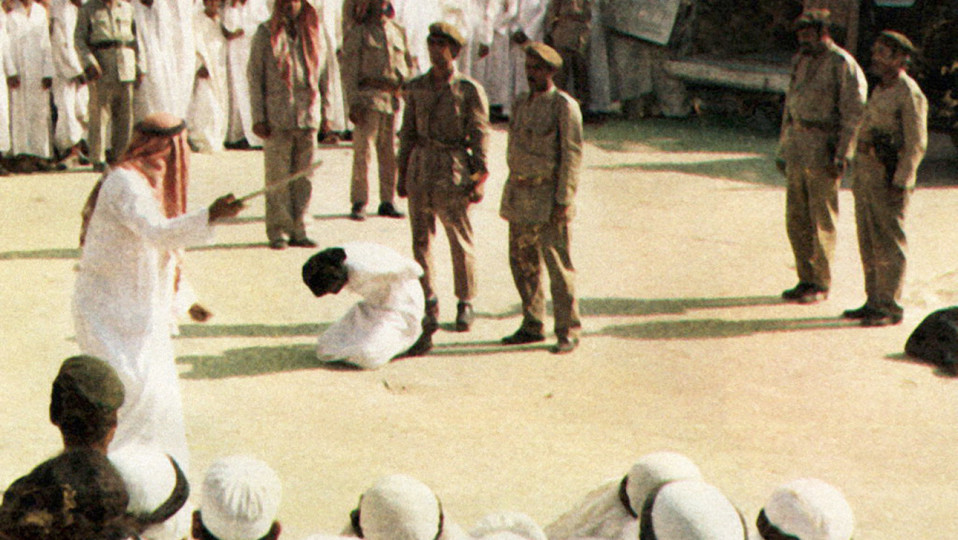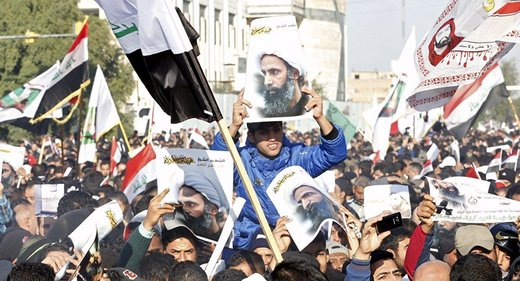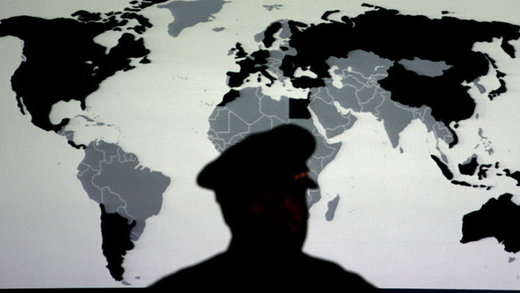‘Suspicious timing’: The geopolitics behind Saudi Arabia’s recent executions & provocations
Andrew Korybko
Sputnik
Riyadh’s execution of Shiite Sheikh Nimr al-Nimr was timed to coincide with the expected lifting of anti-Iranian sanctions and the rejuvenation of the Syrian peace process.
Saudi Arabia just beheaded a prominent anti-government activist and Shiite cleric, Nimr al-Nimr, on trumped-up charges of “terrorism”, executing him alongside suspected al Qaeda fighters. The message Riyadh sent was simple enough — Shiite activists are equivalent to terrorists in the Kingdom’s calculus, and this predictably engendered outrage all across the world, especially in majority-Shiite Iran. The resultant protests, some of which regretfully turned violent and targeted Saudi diplomatic facilities, were cited as ‘proof’ of Iran’s ‘aggression’ against Saudi Arabia and became the publicly presentable reason for why Riyadh cut off all diplomatic and economic ties with Tehran.
Suspicious Timing
Sanctions Removal
The timing of this provocation couldn’t be more suspect, since it convincingly appears as though the Saudis staged it at precisely the moment when Iran was expected to be reintegrated into the global economy. The UNSC sanctions are widely expected to be lifted by the end of the month or early February, and it looks like Saudi Arabia wants to spoil the event by provoking an anti-Iranian maelstrom that puts pressure on the EU to reconsider its planned energy and infrastructure investments in the country.
Ultimately, France and Germany’s economic engagement with Iran will come down to whether or not the US gives them the approval to proceed at their expected pace, and considering how successful Washington was in forcing Brussels to cut its preexisting and very profitable ties with Moscow, it can’t be precluded that it could do the same in obstructing unestablished and still forthcoming deals with Tehran.
Of relevance, the US is prepping a new round of unilateral sanctions against Iran due to the latter’s missile tests in October, indicating a shift in strategic attitude towards the country that strongly suggests a corresponding European reaction.
Syrian Talks
Another event that needs to be brought up in the context of Saudi Arabia’s latest anti-Iranian stunt is that the next round of the Syrian Reconciliation Dialogue is supposed to begin by the end of the month. Various terrorist groups (deemed “moderate rebels” by the mainstream media) already convened in Riyadh in advance of this forthcoming summit in order to receive consultations, so it’s a given that the Saudis hold major influence over an array of on-the-ground militants there.
Curiously, Turkish President Erdogan paid a visit to the Kingdom right before the unannounced execution and shortly after the terrorist gathering, so connecting the anti-Syrian plot points, it looks like the Turkey-Saudi-Qatari bloc of destabilizers plans to undermine both the Geneva intra-Syrian and Vienna extra-Syrian peace talks. As regards the former, they may now order their radical Islamist proxies into making unreasonable demands in order to sabotage the dialogue process, and per the latter, they might threaten to temporarily suspend their participation if Iran isn’t kicked out.
Hidden Motives
Yemen
The Saudis’ War on Yemen has been a dismal failure, yet their leadership is still obsessed with continuing the conflict. They hope that their recent anti-Iranian ruse can prompt the “anti-terror” coalition to increase their supportive contribution to the theater under the guise of “countering Iran”.
The reader should be reminded that it’s less of an “anti-terrorist” organization and more like a quasi-legitimized international mercenary marketplace, so what the Saudis really want is a semi-plausible reasoning for contracting more fighters into the field.
Additionally, the Ansarallah are Shiite, and linking them, their sect, and Iran to “terrorism” in the Sunni sectarian-manufactured mindset is also meant to excuse any large-scale crackdown against Bahraini and Saudi Eastern Province protesters (both of which are majority Shiite) on cooked-up “anti-terrorist” grounds.
The end effect of all of this is to transform the “anti-terrorist” coalition into an anti-Shiite one and institutionalize militant Muslim sectarianism.
Russia
Saudi Arabia and its American “Lead From Behind” masters want to turn the heat up against Iran and punish it for its anti-terrorist cooperation with Russia. The unipolar world, especially the members that invested billions of dollars in regime change terrorists, is angered beyond belief by the success that Russia has had in literally blowing up their assets in Syria.
Considering the active and supporting roles that Iran has played on Russia and Syria’s side, most prominently through the use of military advisors and allowing cruise missile strikes through its airspace, there should have been no doubt that some type of consequences would ensue.
It becomes apparent in hindsight that the US and Saudi Arabia were taking their time in plotting their response, which as is visibly being demonstrated, is a dramatic escalation of the New Cold War. In the full spirit of these tense and exclusionary times, a concentrated effort is being made to ‘isolate’ Iran from the rest of the international Muslim community, most of which is part of the Saudi-led “anti-terrorist” coalition and thus under its organizational influence.
Coup Fears
The last main reason why Saudi Arabia chose this specific time to exacerbate tensions with Iran was to strengthen the role of the Defense Ministry and counter any fears of a royal coup. To explain a bit more, King Salman is largely seen as a ceremonial figurehead that’s physically incapable of governing the country, with the real power resting in the hands of the Minister of Interior and his son, the Minister of Defense. Respectively, these are the Crown Prince and the Deputy Crown Prince, both of which are only in their current positions because of a surprise shake-up in the royal succession a few months after King Abdullah’s death.
Many Saudi royals were unhappy about this decision, and 30-year-old Mohammad bin Salman’s reckless War on Yemen angered them even more. Rumors began to swirl that some of the royals were serious in plotting a coup, and they reached such a fever pitch that The Guardian even reported in late September on a mysterious unnamed prince that was at the forefront of the regime change movement. However thought-out the plot may have been, it’s probably largely sidelined now that tensions have been purposefully ratcheted up with Iran. In the interests of ‘national security’, the pervasive mood is such that no ‘patriotic’ Saudi royal would dare rock the country’s stability at a time when ties with Tehran have never been worse, essentially quelling the internal revolt for as long as the crisis carries on for (and which probably won’t dissipate for quite some time anyhow).
Global Perspective
Wrapping everything up, the tactics of staged provocations and multilateral ‘isolation’ being played against Iran at the moment closely mirror those that were earlier used against Russia. To remind everyone, the US-organized Color Revolution in Ukraine and subsequent nationalist violence created the conditions where Crimea’s residents felt unsafe and opted to reunify with the Russian Federation.
The patriotic uprising in Donbass sprung up almost concurrent with that, and the following Civil War (all of which was American-provoked) was used as the excuse for the West to sanction Russia.
Worse still, NATO exploited this ‘opportunity’ to illegally deepen its presence in Eastern Europe in contravention to the 1997 NATO-Russia Founding Act. Multilaterally and in conjunction with the EU sanctioning Russia and NATO marching ever more determined to the east, the entirety of Central and Eastern Europe aside from Belarus, Serbia, and the Republic of Macedonia united in presenting a singular front against Russia.
At the beginning of 2016, almost the exact same thing is now happening to Iran. Saudi Arabia chose to savagely behead Sheikh al-Nimr in order to create the ‘Ukrainian-like’ chain of destabilizing excuses to ‘justify’ a preplanned multilateral response against Iran. Just as NATO and the EU teamed up against Russia, it now looks like the Saudis’ “anti-terrorist” coalition and other Riyadh-dominated Mideast institutions will do the same against Iran. Altogether, the general strategy is to create ‘containment’ coalitions across Eurasia in a desperate bit to hem in the most active multipolar forces in the supercontinent, be it Russia in Eastern Europe or Iran in the Mideast.
Accordingly, it follows that China will be next, and the preconditioning necessary for the next preplanned provocative action is already being practiced in the South China Sea. If some members of ASEAN such as Vietnam and the Philippines formally team up with the US and Japan to ‘contain’ China, then the three multipolar Great Powers will only have the shared space of Central Asia between them to exercise strategic maneuverability. As a result, the Eurasian Heartland would become ground zero for the next regional destabilization, be it a ‘Central Asian Spring’ or an ISIS-like terrorist invasion, albeit one which has the potential to offset all three multipolar leaders in one fell swoop.
___
http://www.sott.net/article/309944-Suspicious-timing-The-geopolitics-behind-Saudi-Arabias-recent-executions-provocations


